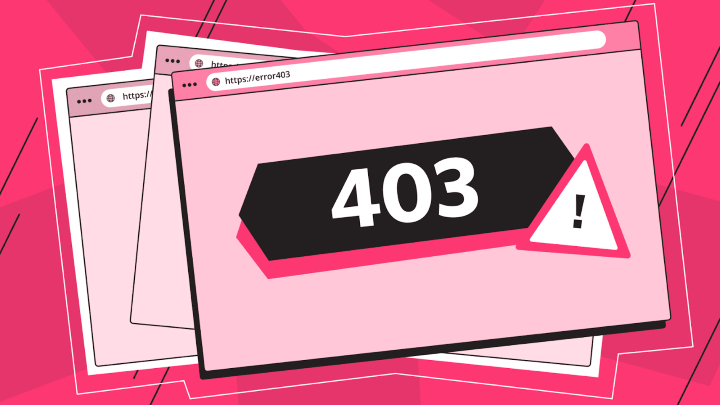Decoding Open Proxies: The Reason Behind Your Flagged IP Address

Navigating the digital landscape with open proxies is like walking a tightrope. On one side, there’s the allure of anonymity, the promise of surfing the web incognito. On the other, there’s the potential plunge into a net of security risks and flagged IP addresses. It’s a balance; not every proxy keeps you steady on that rope.
If you’ve ever been puzzled by a flagged IP while believing you were under the radar, or if you’re just starting to explore the intricate maze of online security, this guide is your map. Together, we’ll navigate the twists and turns of open services, ensuring you’re equipped to make informed decisions in the digital realm.
What are Open Proxies?
In online security, the term “proxy” is often thrown around, but not always with a clear definition. So, let’s demystify this: What exactly are these services?
An open proxy is a server that acts as an intermediary between a user’s device (like a computer or smartphone) and the internet. When you send a request to visit a website, the request first travels to the proxy server instead of going directly from your device to the site and then to the website. When the website responds, the proxy server receives the data and returns it to you. The key feature of an open service is that it’s accessible to any internet user without needing authentication.
How They Differ from Other Types of Proxies
In my experience with proxies, I’ve noticed that not all of them are on the same playing field, though their primary function is to forward web requests. I’ve come across open proxy services that are publicly accessible and often don’t cost a dime. They are quite different from private or dedicated services, which are exclusive and typically come with a price tag. I’ve also dabbled with residential proxies, which use IP addresses given by ISPs, making your online presence seem just like any other regular internet user. Datacenter proxies come from a secondary corporation and, while they offer me faster speeds, they might give away my use of a proxy more easily.
Common Uses of Open Proxies
In my journey through the world of cybersecurity, I’ve seen these technologies rise in popularity for several compelling reasons. What do I use the open proxies for?
- Bypassing Geo-Restrictions: Open servers are a perfect match for sidestepping those pesky geographical content barriers. This lets me access sites or services that might otherwise be off-limits in my area.
- Web Scraping: I’ve noticed that many in the community use these services for web scraping. When I use a proxy for this, it helps me hide my tracks, making it trickier for sites to spot and block my attempts.
- Perceived Anonymity: One of the main reasons I’m drawn to these tools is the allure of online anonymity. It gives me the confidence that I can surf the web without exposing my IP, keeping my online escapades under wraps.
The Allure of Open Proxies

In the vast digital marketplace, these proxies often appear as the go-to solution for those seeking online anonymity. Their primary attractions include:
- Cost-Effectiveness: Open proxy services, especially the free ones, appeal to those looking for budget-friendly solutions.
- Ease of Access: Their widespread availability and lack of sign-up requirements make them convenient.
- Perceived Power: The ability to bypass geo-restrictions and mask online activities gives users a sense of control over their digital footprint.
However, it’s crucial to differentiate between the perceived benefits and the actual risks. The notion of “free internet privacy” can be misleading, and users must know the potential security pitfalls.
The Dark Side of Open Proxies
While I was initially dazzled by the allure of online anonymity and unrestricted access these technologies promised, I’ve learned the hard way that not everything that glitters is gold. Delving deeper into my own experiences, I’ve encountered the darker sides of these services that I believe everyone should be wary of.
Security Risks
- Malicious Proxy Operators: Not every open proxy I’ve come across had my best interests at heart. I’ve stumbled upon some that were set up by malicious actors, aiming to harvest data from unsuspecting users like me. When I routed my traffic through these proxies, I realized the operators could easily log sensitive details, from login credentials to personal information.
- Data Interception and Man-in-the-Middle Attacks: I’ve learned that these technologies can be hotspots for man-in-the-middle (MITM) attacks. I’ve been in situations where the proxy intercepted the data I was transmitting to a website. It was a stark reminder that any unencrypted data I send or receive could be in the hands of someone with ill intentions, ready to view, alter, or steal it.
Performance Issues
- Slow Connection Speeds: “Free” and “easily accessible” often mean “overcrowded.” I’ve been one of many trying to use the same open proxy. And the outcome? Agonizingly slow connection speeds turned my browsing sessions into exercises in patience.
- Unreliable Uptime: I’ve also found that stability isn’t a hallmark of many open proxy services I’ve tried. Their performance can be wildly inconsistent. One moment I’m smoothly surfing, and the next, I’m abruptly disconnected, left in the lurch without any heads-up.
Legal and Ethical Concerns
- Use in Cyberattacks: I’ve seen firsthand how open proxy services can be turned into weapons. Cybercriminals often use them to launch attacks, masking their actual location and identity. If you’re using a proxy involved in malicious activities, your IP could get flagged or blocklisted, even unknowingly.
- Potential for Accessing Illegal Content: These proxies’ veil of anonymity can sometimes encourage users to access illegal or prohibited content in their region. However, remember that complete anonymity is a myth. Authorities can still trace back activities in many cases, leading to potential legal repercussions.
Why Your IP Gets Flagged When Using Open Proxies

Like our physical world, the digital realm has its own traffic rules. Just as vehicles get flagged for breaking road regulations, IP addresses can get flagged for suspicious online activities. But why does this happen, especially when using open proxy services? I am going to guide you through the intricacies.
Explanation of IP Blocklists
IP blocklists are databases that various organizations, websites, and service providers maintain. These lists contain IP addresses identified as sources of spam, malicious activities, or other unwanted behavior. The primary purpose? To protect users and systems from potential threats. When an IP address lands on one of these blocklists, it can be restricted from accessing certain online services, websites, or networks.
How Proxies Get Detected and Flagged
Navigating the digital landscape with this proxy type might seem stealthy. Still, the reality is that these services are often under the watchful eyes of vigilant security systems. Here’s how these seemingly invisible cloaks get spotted and flagged:
- Volume of Requests: While these technologies are easy to access, they often get overwhelmed with a deluge of requests. I’ve noticed that websites and their security systems can spot an unusually high number of requests coming from a single IP, which immediately raises suspicions.
- Suspicious Activities: There were times when I used an open proxy that, unbeknownst to me, was involved in malicious deeds like cyberattacks or spamming. It didn’t take long before these activities were spotted, and the proxy was blocked.
- Known IP Ranges: I’ve learned that many proxies have specific IP ranges tied to data centers. Websites can spot these ranges, and they tend to flag them since regular folks like me usually don’t browse from data center IPs.
- Consistent Patterns: I’ve seen automated tools and bots frequently use these proxies. When a website picks up on repetitive, non-human-like patterns from an IP, it often gets flagged as suspicious.
The Repercussions of Having a Flagged IP
When your IP gets flagged, it can cast a shadow over your online activities, leading to a cascade of challenges. Here are some of the potential repercussions of operating with a flagged IP:
- Access Denied: One of the most immediate consequences is being blocked from specific websites or services. It can be particularly frustrating if you’re trying to access essential services or platforms.
- Reputation Damage: If you’re running a business, having a flagged IP can harm your reputation. Emails might land in spam folders, or clients could face issues accessing your services.
- Remediation Efforts: Getting off a blacklist isn’t always straightforward. It can require reaching out to multiple organizations, proving that the malicious activities have ceased, and ensuring better security practices in the future.
Personal Experience: A Cautionary Tale
Throughout my decade in cybersecurity, I’ve navigated complex challenges and witnessed the rapid evolution of threats. One incident, in particular, underscores the hidden dangers of open proxy services.
A few years ago, I was approached by a client, an emerging e-commerce platform, to conduct a comprehensive security audit. Their goal was clear: to fortify their digital defenses and ensure a secure user environment. I employed a suite of advanced penetration testing tools and methodologies to achieve this. One of my strategies was to test the platform’s geo-restriction capabilities. For this, I used an open proxy I found during my research. It seemed like a straightforward solution to simulate access from a different geographical location.
The audit began seamlessly. The platform demonstrated robust security measures, effectively thwarting most of my simulated attacks. But then, unexpectedly, I hit a wall. I was abruptly locked out, not just from the client’s platform but also from several other critical services I rely on. My IP address had been flagged and blocklisted.
Diving deeper using network forensic tools, I uncovered a disturbing revelation. The open proxy I had chosen was more than just routing my legitimate test traffic. It was concurrently being exploited in a Distributed Denial of Service (DDoS) attack against another major platform. This malicious activity led to the blockage of my IP address (which I was sharing via the proxy across a wide array of services.
To mitigate the situation, I immediately:
- Disengaged from the compromised proxy: I switched to a trusted VPN to ensure a secure and clean connection.
- Communicated with the client: I informed them of the situation, ensuring transparency and collaboration in addressing the issue.
- Engaged with blocklisting entities: Using tools like MXToolbox and Spamhaus, I identified where the IP was blocked and initiated the delisting process, providing necessary evidence and assurances of the non-malicious nature of my activities.
Key takeaways from this ordeal were:
- Never Underestimate the Risks: Even experts aren’t immune to the unpredictable nature of open proxy services.
- Thoroughly Vet Resources: Always ensure that tools, especially those from the internet, are from reputable sources and have been thoroughly vetted.
- Always Have a Contingency Plan: In the cybersecurity industry, it’s about preventing issues and having a robust response strategy when things go awry.
This incident served as a stark reminder of the complexities of the digital realm. In cybersecurity, the learning curve is perpetual, and staying vigilant is not just a recommendation — it’s a necessity.
The Right Way to Use Proxies
Navigating the vast world of proxies can be daunting, especially with the myriad options available. But fear not! With over a decade in cybersecurity, I’ve sifted through the noise to bring you the essentials of using proxies correctly.
Paid vs. Free Proxies
The age-old debate: to pay or not to pay? When it comes to proxies, the answer becomes clearer.
- Reliability: Free proxies can be enticing, but they often come with the cost of unreliability. Paid proxies, on the other hand, guarantee a certain level of uptime and consistent performance.
- Security: With free proxies, there’s always a question: Who’s behind this service? Paid proxies typically come from reputable providers who prioritize user security.
- Support: Have you ever encountered an issue and wished you had someone to help? You often get dedicated support to assist with any challenges with paid proxies.
Investing in a good proxy service can save you from unforeseen troubles. Wait! Does it mean that budgeting and proxies are incompatible? Well, I’ve compiled the list of reputable free proxies I’ve hand-tested and am sure about their reliability. So, if you’re on a tight budget — go for these options.
Importance of SSL Encryption
Data security is paramount. As you route your traffic through a proxy, ensure your data remains encrypted.
What is SSL?
Originally, SSL (Secure Socket Layer) was the standard protocol for encrypting data transfers between devices and servers. However, as cyber threats evolved, so did encryption protocols. SSL was succeeded by TLS (Transport Layer Security), a more advanced and secure version. Despite the transition, “SSL” is still commonly used to describe encryption.
Why It Matters
Encryption, whether through SSL or TLS, ensures data is transmitted securely. It prevents potential eavesdroppers from intercepting and deciphering the data, safeguarding sensitive information like login credentials and personal details. Always verify that the proxy service you choose supports up-to-date encryption standards.
By the way, if you want to dive deep into encryption, please view my article here. With it, you will get a complete look at the role of encryption and its nuances.
Conclusion
Navigating the digital realm can often feel like traversing a minefield, especially when it comes to the use of proxies. It’s evident that while they offer convenience, they come with a baggage of risks. The pitfalls are numerous, from potential security breaches to the looming threat of having your IP flagged. Prioritizing safety and security over mere convenience is not just a recommendation; it’s necessary in today’s cyber landscape.
I’ve been in the cybersecurity field for over a decade, and if there’s one thing I’ve learned, it’s that informed choices are your best defense. Equip yourself with knowledge, be discerning in your proxy choices, and always prioritize your digital safety.
